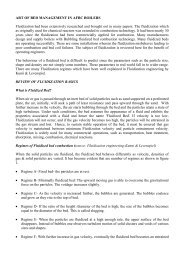Create successful ePaper yourself
Turn your PDF publications into a flip-book with our unique Google optimized e-Paper software.
2. Operation <strong>of</strong> the boiler with<strong>in</strong> narrow range <strong>of</strong> phosphate <strong>of</strong>fers a time delay aga<strong>in</strong>st unavoidable<br />
failure.<br />
WHAT IS TO BE DONE TO PREVENT THE FAILURES IN FUTURE?<br />
When it was zeroed down that the angle <strong>of</strong> slope <strong>of</strong> the <strong>bed</strong> coil was the prime cause for failure, the<br />
next question was how to rectify the design defect.<br />
1. To prevent failure the slope <strong>of</strong> the tube has to be raised. In many cases the <strong>in</strong>crease <strong>in</strong> angle would<br />
have resulted <strong>in</strong> less <strong>bed</strong> HTA. Alternate configurations have to be thought <strong>of</strong> to avoid lower<br />
slopes. While replacement <strong>of</strong> <strong>bed</strong> <strong>tubes</strong> <strong>in</strong>creased slopes shall be considered. This conclusion was<br />
based on one boiler operat<strong>in</strong>g with 10 deg slope at 110 kg/cm2 <strong>pressure</strong>.<br />
2. The circulation ratio can be improved by adopt<strong>in</strong>g better designed downcomer riser layout. We can<br />
not adopt a common downcomer system for two circuits which have different heat flux. This<br />
mistake is seen <strong>in</strong> some units: the downcomer is common for water walls that were hav<strong>in</strong>g less<br />
steam<strong>in</strong>g rates. In such circuits there will be poor flow rates. This also reduces the mass flow rate<br />
<strong>in</strong> <strong>bed</strong> <strong>tubes</strong> depend<strong>in</strong>g upon how the branch<strong>in</strong>g is done.<br />
3. Rifle bore / <strong>in</strong>ternally rib<strong>bed</strong> <strong>tubes</strong> are to be used to enhance mix<strong>in</strong>g <strong>of</strong> steam and water. In the<br />
<strong>in</strong>stallations where the <strong>tubes</strong> had already failed this was the only solution. Rifle bore <strong>tubes</strong> have<br />
spiral ribs which impart swirl<strong>in</strong>g motion to steam-water mixture flow<strong>in</strong>g through the <strong>tubes</strong>. The<br />
mix<strong>in</strong>g <strong>of</strong> steam & water ensures the constituents <strong>of</strong> water <strong>in</strong>side the tube are the same as that <strong>of</strong><br />
bulk water. Rifle bore / <strong>in</strong>ternally rib<strong>bed</strong> <strong>tubes</strong> are be<strong>in</strong>g used <strong>in</strong> once-through <strong>boilers</strong>. In future for<br />
88 kg/cm2 and beyond, rifle bore <strong>tubes</strong> are to be used.<br />
A REVIEW OF CAUSTIC GOUGING MECHANISMS<br />
<strong>Caustic</strong> <strong>goug<strong>in</strong>g</strong> is a form <strong>of</strong> corrosion <strong>of</strong> steel. It generally results from fouled heat<strong>in</strong>g surface and the<br />
active corrodent (sodium hydroxide) <strong>in</strong> the boiler water. Concentrated solutions <strong>of</strong> alkali occur <strong>in</strong><br />
situations where the normal water wash<strong>in</strong>g <strong>of</strong> tube metal is restricted after the steam bubble release.<br />
The concentrations <strong>of</strong> corrosive solutions occur at the heat transfer surfaces as the result <strong>of</strong> foul<strong>in</strong>g by<br />
porous deposits such as iron and copper oxides. These deposits are typically formed from particles<br />
suspended <strong>in</strong> boiler water. Once the corrosive concentration mechanism is started, the additional<br />
corrosion products are generated from porous deposits. Boil<strong>in</strong>g under the deposits is <strong>of</strong>ten referred as<br />
Wick boil<strong>in</strong>g. Boiler water permeates the porous deposit by capillary action through small pores like a<br />
liquid permeat<strong>in</strong>g a wick. Steam then escapes through the larger pores (channels) leav<strong>in</strong>g non volatile<br />
solutes beh<strong>in</strong>d. These new deposits then concentrate beneath deposits.<br />
Feedwater solids concentrate <strong>in</strong> the boiler relative to blow down rates. Boiler water solids may<br />
concentrate an additional 2000 times at the heat transfer surface as a result <strong>of</strong> a concentrat<strong>in</strong>g film<br />
produced from non boil<strong>in</strong>g equilibrium. The formation <strong>of</strong> a steam bubble further concentrates boiler<br />
solids. These conditions are most likely reached <strong>in</strong> the presence <strong>of</strong> porous deposit.<br />
Once the local caustic concentrations are reached such that caustic attack occurs, the corrosion can<br />
proceed to failure <strong>in</strong> a very short time. <strong>Caustic</strong> corrosion is an irregular th<strong>in</strong>n<strong>in</strong>g or <strong>goug<strong>in</strong>g</strong> <strong>of</strong> the tube<br />
water side surface. Areas subject to caustic attack typically show smooth round roll<strong>in</strong>g contours<br />
surrounded by encrusted boiler water solids and crystall<strong>in</strong>e dense oxides. The oxides however are not<br />
protective. Particles <strong>of</strong> metallic copper may also be em<strong>bed</strong>ded <strong>in</strong> the deposit layer.<br />
Failures due to caustic attack are caused by metal loss. The damage progresses to failure when the tube<br />
wall th<strong>in</strong>s to a po<strong>in</strong>t where rupture occurs locally. The microstructure does not change and the tube<br />
metal reta<strong>in</strong>s ductility.<br />
<strong>Caustic</strong> attack can also lead to other type <strong>of</strong> failures. One form is the hydrogen damage which results<br />
from hydrogen liberated <strong>in</strong> the corrosion process diffus<strong>in</strong>g <strong>in</strong> to the metal. The hydrogen can then

















